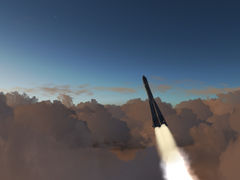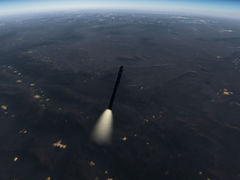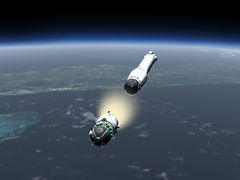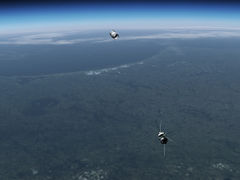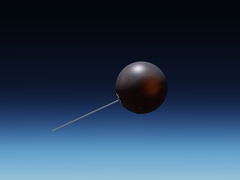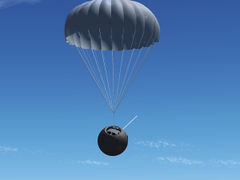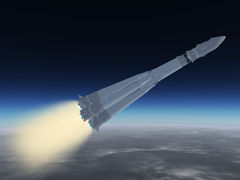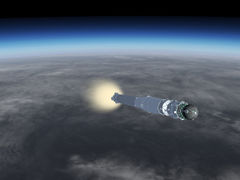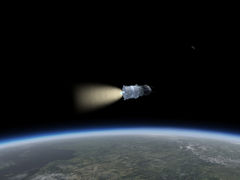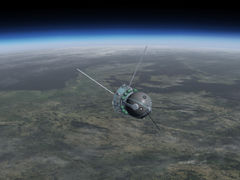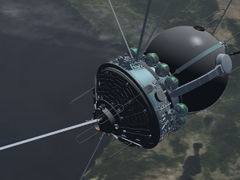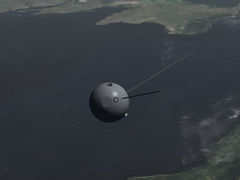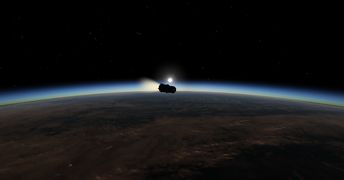Vostok-1
 | |
|---|---|
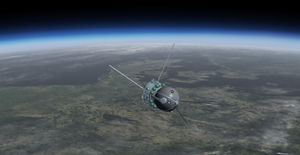 | |
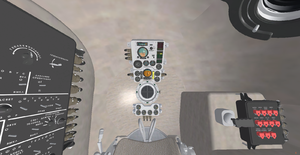 | |
| Type | Spacecraft, Rocket |
| Author(s) | Victor Slavutinsky, Thorsten Renk |
| FDM | JSBSim |
| --aircraft= | Vostok-1 |
| Status | Production |
| FDM |
|
| Systems |
|
| Cockpit |
|
| Model |
|
| Supports |
|
| Development | |
| Website |
|
| Repository |
|
| Download |
|
| License | GPLv2+ |
|
| |
| Space flight |
|---|
| in FlightGear |
| Space Shuttle |
| Vostok-1 |
Vostok-1 was the first manned spaceflight in history, done by Yuri Gagarin in 1961. The launch vehicle was a Vostok-K rocket carrying the Vostok-3KA capsule.
While the historical space mission was under fully automatic control and Gagarin ejected from the capsule at an altitude of 7 km and parachuted to the ground, the simulation in Flightgear has to be flown manually and lands the capsule itself via parachutes. To that aim, an extra control panel to manage the various stages of the rocket which is not present in the real capsule has been added at the right side of the cockpit.
Characteristics of the Vostok-K carrier
The Vostok-K is a three stage rocket. All three stages are powered by RP-1 (a kerosene-like rocket propellant) and liquid oxygene. It works partially with a parallel-burn concept.
The first stage consists of four boosters with a total thrust of 3,883.4 kN. They ignite in parallel with the second stage with a thrust of 912 kN.
The boosters have a burn time of about 118 seconds and are jettisoned when empty. In the later stages of the booster burn, the rocket can reach accelerations in excess of 4 g (the structural limit) and the engines need to be throttled back.
The second stage has a burn duration of 301 seconds and is also discarded when empty. Just as with the boosters, the acceleration may reach the structural limit towards the end of the burn as the tanks deplete.
The third stage has a much lower thrust of 54.5 kN leading to about 0.5 g acceleration. It is used to nudge the capsule into a stable orbit and has a burn duration of 365 seconds.
Control during ascent is provided by maneuvering thrusters rather than thrust vector control by gimbaling the main engines. As a result, Vostok's response to control input in powered flight is considerably less crisp than that of e.g. the Space Shuttle.
Limits and damage
The modeling of Vostok includes structural limit checks. Upon ascent, the various parts of the rocket can break when overstressed either by too high dynamical pressure or g-forces. Often this leads to loss of control as the maneuver engines are not powerful enough to compensate for e.g. the loss of a booster and the resulting asymmetric thrust.
In addition, the pilot chute can tear off if deployed at too high dynamical pressure, just as the main chute and and the landing engine sensor.
For the detailed limits in all stages of the flight, please refer to the manual coming with the spacecraft.
Automated launch
The spacecraft is equipped with a simple launch AP. This is (intentionally, to reflect the early spaceflight capabilities) made to be not precise and cannot be used for e.g. rendezvous targeting, but it can fly the capsule into a stable orbit. The target orbit can be specified in the menu, and the AP is capable of fully controlling the spacecraft right to third stage separation.
There is a one-way option provided to take over manually in case of an AP malfunction - note that controls can not be handed back to the autopilot.
Simulation options
The simulation provides the options to make discarded stages simply vanish (easier on system resources) or to simulate them as they fall away or, in the case of third stage and TDU, orbit together with the spacecraft for a while.
For technical reasons, the option to simulate the drop of the boosters is really a startup option - the user selection will be autosaved and used upon next startup.
In addition, the simulation provides the option to automatically switch to the Earthview renderer when a certain altitude is reached and to switch back to the normal renderer when the spacecraft returns to Earth.
Developer's message
Well, what can I say? You know what.
Real Vostok-1 was fully automated. The purpose of "Vostok-1" FG project, aside other things, is to give to You some understanding of spaceflight by giving to You full control from lift-off to landing. Perhaps there will be some automatic orbit and de-orbit in the future, but not now.
There are many things which would be realized. At now it's possible to "fly" around "Earth".
P.S. I could not and won't be responsible of what's going on with model after I had quit development of it, since of conflict instead of friendship, at 2011, when it was "now". As I made model GPL, whoever may do anything with it, and it's up to community, which conflicted with idea of spaceflight then, and suddenly changed it's mind with "Shuttle" model development next, if it not works way it should, not looks as it should, etc. Same with my "MiG-15" model. It's as really working thing may not work at news of some country, and it's not problem of people who made that thing, but of ones views of whom are cut short voluntary. Basically, I just don't care, as it useless with those.
If You mean some friendship, You may look at my "Su-15" model instead, which no-one with arguing/competitive/conflict mind having right, and, though, ability to put hands on.
Wish to You good flight,
Victor Slavutinsky, vitosnet@mail.ru.
Gallery
Current:
Historic:

